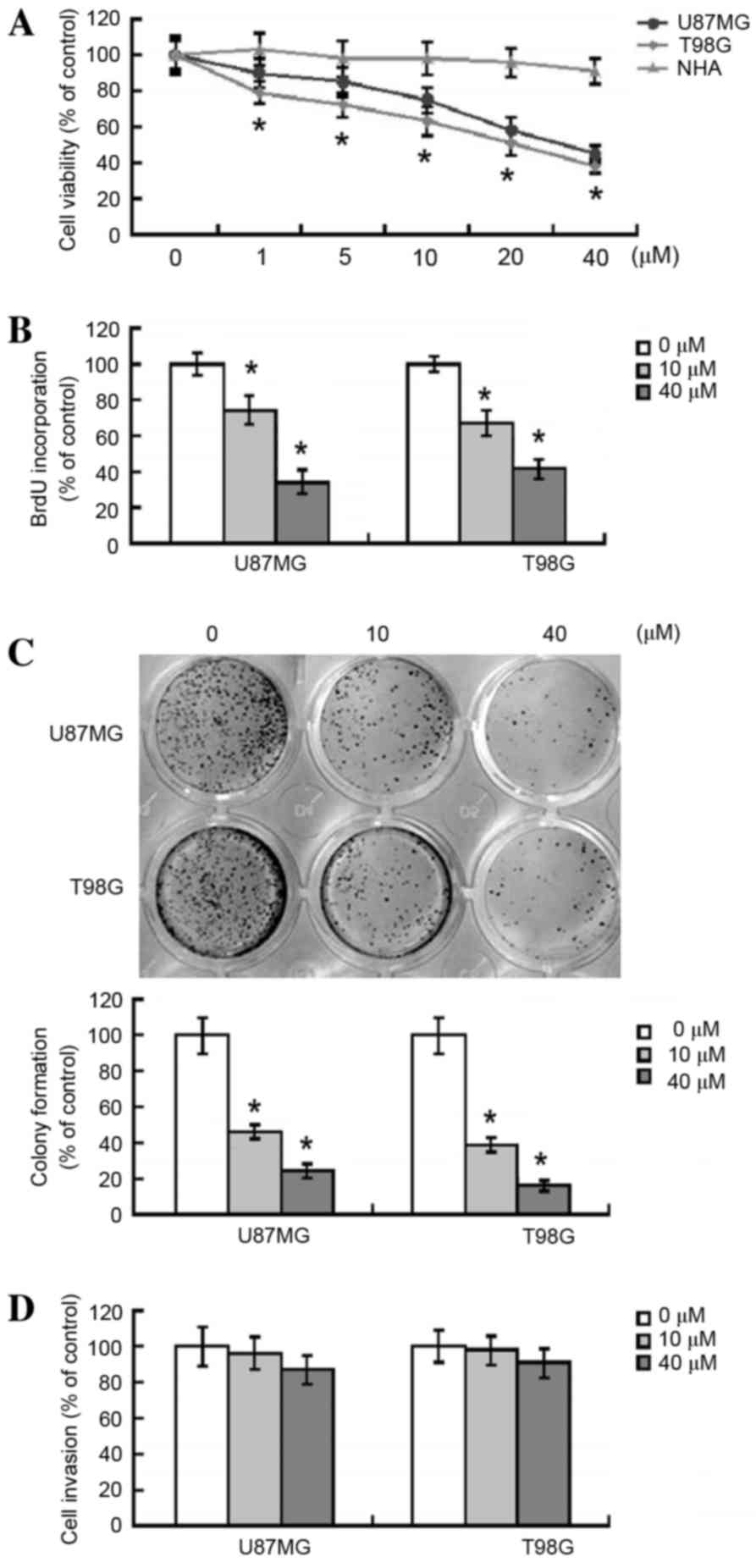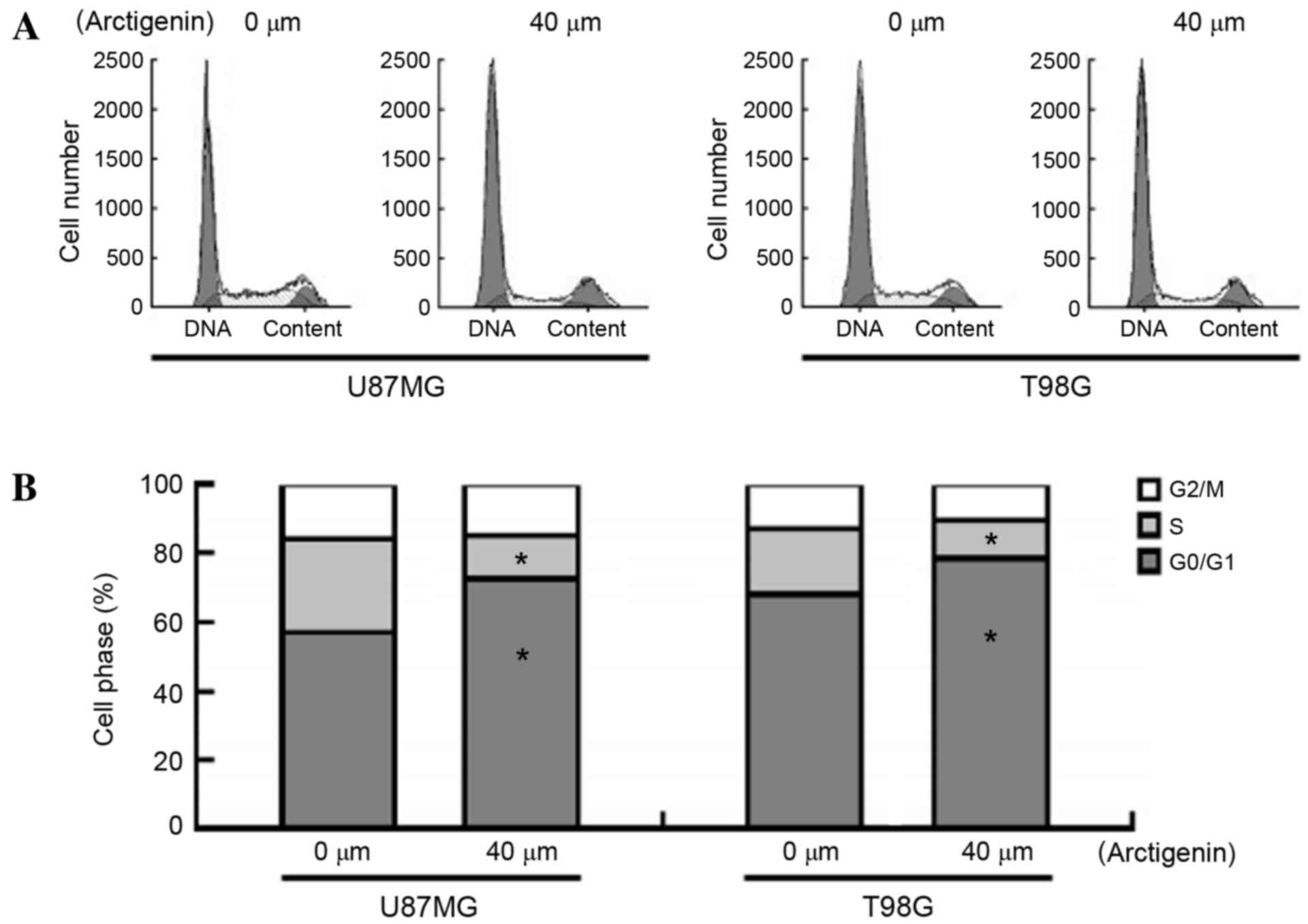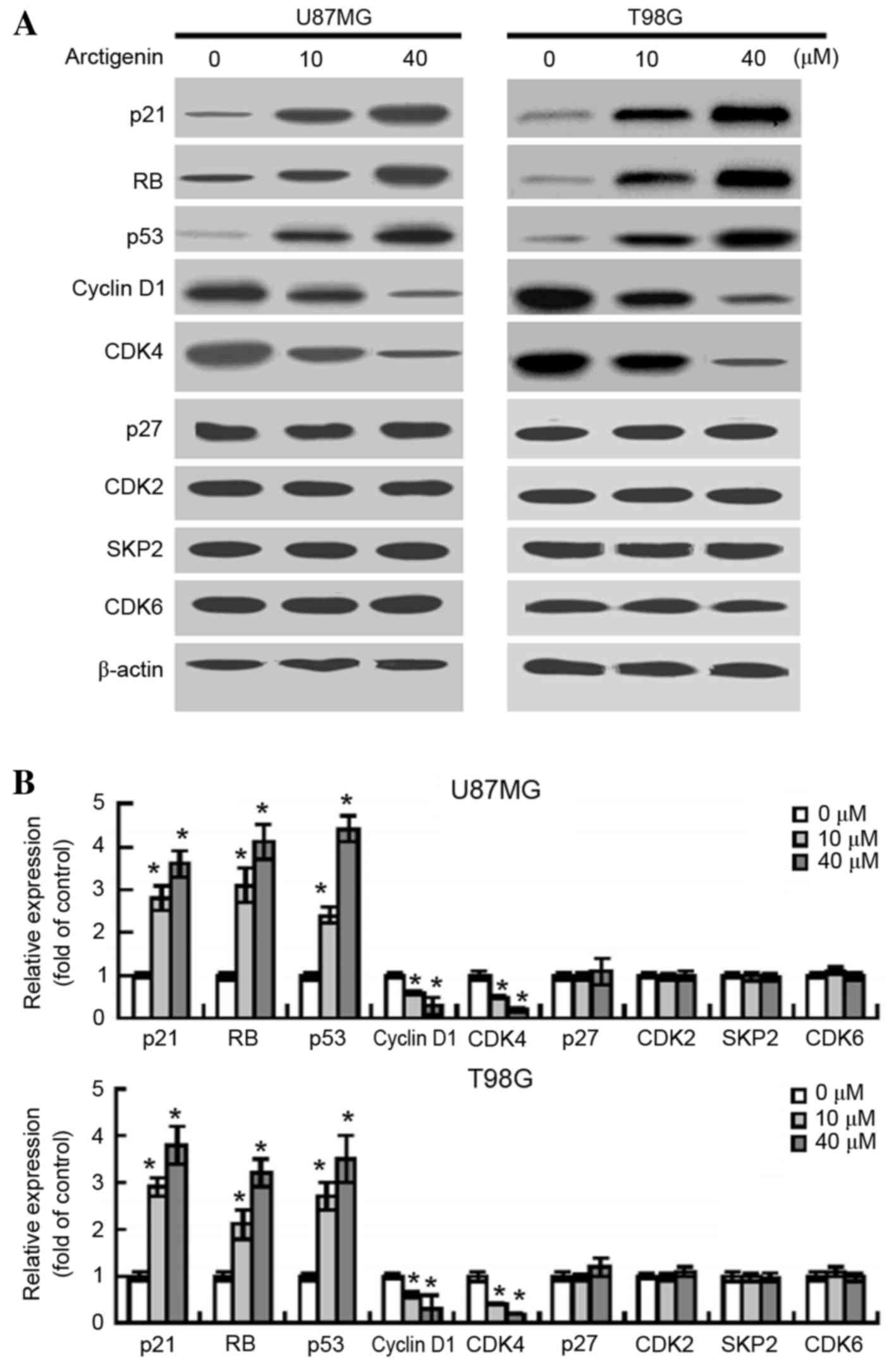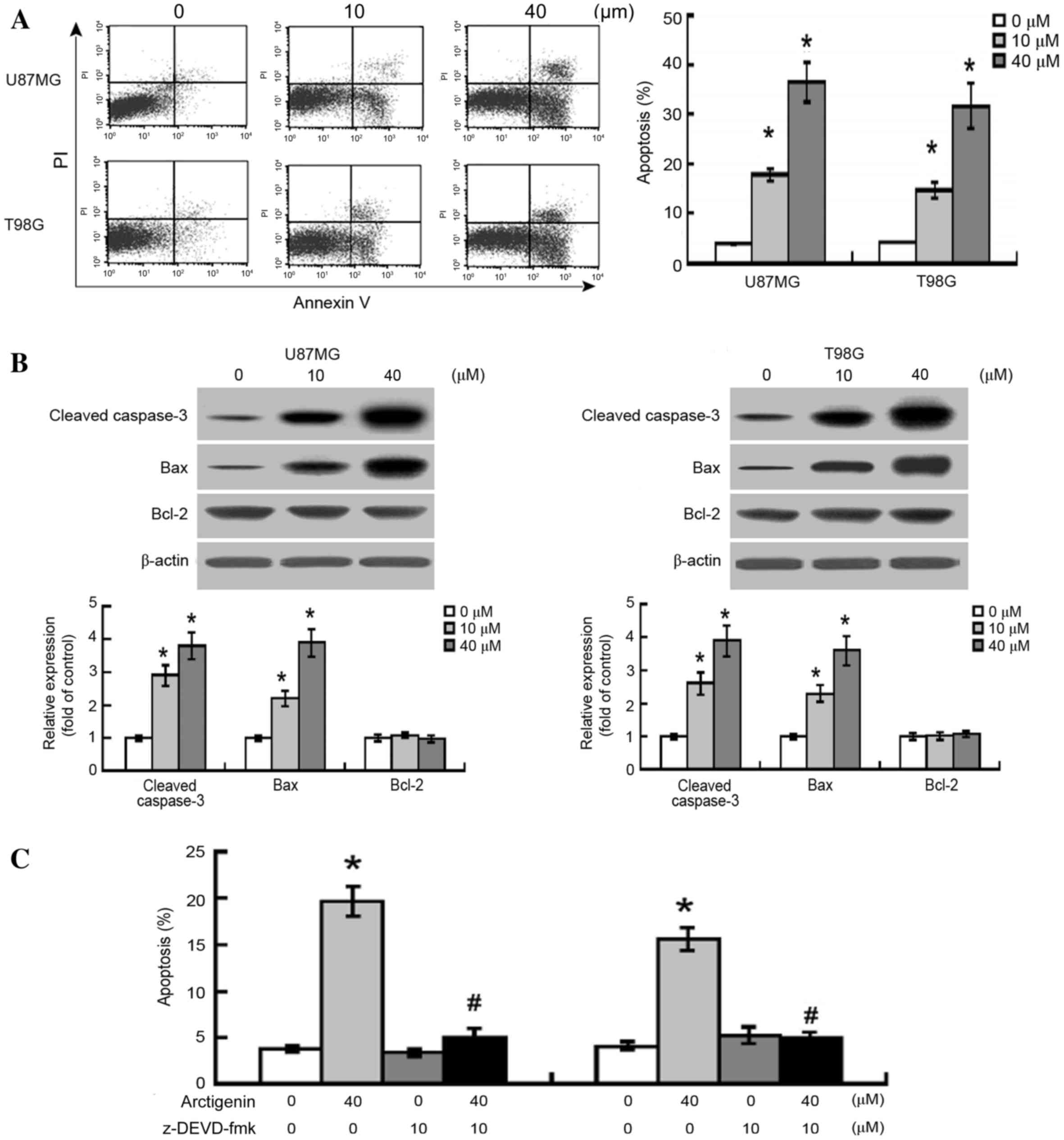Arctigenin, a natural lignan compound, induces G0/G1 cell cycle arrest and apoptosis in human glioma cells
Retraction in: /10.3892/ol.2023.14173
- Authors:
- Published online on: December 8, 2016 https://doi.org/10.3892/ol.2016.5474
- Pages: 1007-1013
Abstract
Introduction
Human glioma is one of the most common primary tumors of the central nervous system, with a high proliferative and invasive capacity (1). Although chemotherapy, radiotherapy and microsurgery have previously been used to treat gliomas, the majority of patients succumb to the disease within two years of the diagnosis (2). Therefore, there is an urgent requirement to develop novel and effective therapies for patients with glioma.
Cell growth and cell death are two critical factors involved in the homeostasis of normal cells; however, in cancer cells, homeostasis is often disrupted by the dysregulation of the cell cycle mechanism (3). The mammalian cell cycle is divided into four distinct phases: G1, S, G2 and M. Cyclins, cyclin-dependent kinases (CDKs) and CDK inhibitors are critical regulators of mammalian cell cycle progression (4). Each phase of the cell cycle is regulated by various CDKs and their individual regulatory cyclins. Induction of cell cycle arrest at different cell cycle checkpoints contributes to various antitumor effects (5). The induction of apoptosis, which typically involves the activation of various caspases, including caspase-3, represents an important underlying mechanism for the elimination of tumor cells (6).
Arctigenin is a natural lignan compound that is extracted from the seeds of Arctium lappa and possesses various pharmacological properties, including antiproliferative, anti-inflammatory, antioxidant, antiviral, immunomodulation, neuroprotective and antidiabetic effects (7). Arctigenin has demonstrated anticancer activities in numerous types of cancer, including gastric cancer (8), breast cancer (9) and ovarian cancer (10). However, the effects of arctigenin on the aggressive phenotypes of human glioma cells remain unclear. In the present study, the effects of arctigenin on the proliferation, colony formation and invasion of glioma cells were investigated, and the effects on the cell cycle distribution and cell apoptosis were also assessed.
Materials and methods
Cell culture and treatment
U87MG and T98G human glioma cells were purchased from the American Type Culture Collection (ATCC, Manassas, VA, USA). Normal human astrocytes (NHA) were purchased from ScienCell Research Laboratories, Inc., (Carlsbad, CA, USA). Cells were cultured in high-glucose Dulbecco's modified Eagle's medium (DMEM) supplemented with 10% fetal bovine serum (FBS; both Invitrogen; Thermo Fisher Scientific, Inc. Waltham, MA, USA), and were treated with various concentrations (1, 5, 10, 20 and 40 µM) of arctigenin (Sigma-Aldrich; Merck Millipore, Darmstadt, Germany) for 24 or 48 h at 37°C before being subjected to further analyses. Dimethyl sulfoxide (DMSO; 0.5%) was used as the vehicle control. In specific cases, the cells were pre-treated for 1 h with 10 µM Z-DEVD-FMK (Calbiochem; EMD Millipore, Billerica, MA, USA), a general inhibitor of caspase-3, prior to their exposure to arctigenin.
Cell viability assay
Cell viability was evaluated using a 3-(4,5-dimethylthiazol-2-yl)-2,5-diphenyltetrazolium bromide (MTT) assay (Sigma-Aldrich; Merck Millipore). The cells were seeded into 96-well plates (2×104 cells/well) and incubated with 1, 5, 10, 20 or 40 µM arctigenin for 48 h. Subsequently, MTT solution was added to each well and the cells were incubated in the dark at 37°C for 4 h. The formazan crystals were solubilized in 100 µl DMSO and the plates were evaluated using a multiwell spectrophotometer (VersaMax Microplate Reader; Molecular Devices, LLC, Sunnyvale, CA, USA) at a wavelength of 570 nm. All experiments were performed in triplicate and the relative cell viability (%) was normalized to the vehicle-treated control cells.
Bromodeoxyuridine (BrdU) incorporation assay
Cells were seeded into 96-well plates (5×103 cells/well) and allowed to adhere overnight. Arctigenin was added to the culture medium and incubated with the cells for 48 h. BrdU reagent (5 µM; Sigma-Aldrich; Merck Millipore) was added to each well and the cells were incubated for an additional 2–4 h. The cells were then incubated with a mouse anti-BrdU monoclonal primary antibody (1:300; cat. no. B8434) for 2 h at 37°C and a fluorescein isothiocyanate (FITC)-labeled anti-mouse IgG secondary antibody (1:2,000; cat. no. F9137; both Sigma-Aldrich; Merck Millipore) for 30 min at room temperature. The cells were subsequently stained with DAPI (Sigma-Aldrich; Merck Millipore) prior to imaging using fluorescence microscopy. The number of BrdU-positive cells was determined amongst 500 randomly selected tumor cells.
Colony formation assay
Cells (1,000 cells/well) seeded into 6-well plates and exposed to arctigenin (10 or 20 µM) for 48 h at 37°C, and were subsequently incubated in fresh medium for an additional 10 days at 37°C. The cells were then fixed in 4% paraformaldehyde and stained with 0.1% crystal violet (Sigma-Aldrich; Merck Millipore). The colonies containing >50 cells were identified and counted using a phase-contrast microscope.
Matrigel invasion assay
A total of 2×104 cells were suspended in serum-free DMEM containing various concentrations of arctigenin (10 or 40 µM) and added to the Matrigel-coated upper chambers of Transwell inserts. Medium supplemented with 10% FBS was added to the lower chambers. Following incubation for 48 h at 37°C, the cells on the upper surface of the filters were removed using cotton swabs. The cells that had invaded to the lower surface of the filters were fixed in 70% ethanol, stained with Giemsa (Sigma-Aldrich; Merck Millipore) and counted.
Cell cycle analysis
Following treatment with arctigenin for 48 h, the cells were harvested by trypsinization, washed twice with PBS and fixed in ice-cold 70% ethanol. The cells were then washed again, subjected to RNase A at a final concentration of 0.05 mg/ml (Sigma-Aldrich; Merck Millipore), and incubated with 10 µg/ml propidium iodide (PI; Sigma-Aldrich; Merck Millipore) at 4°C for 15 min in the dark. Cell cycle analysis was conducted using a FACSCalibur flow cytometer (BD Biosciences, San Jose, CA, USA).
Apoptosis analysis
In order to analyze cell apoptosis in arctigenin-treated cells, FITC-labeled annexin V/PI staining was performed using the FITC-labeled Annexin V Apoptosis Detection kit, according to the manufacturer's instructions (Nanjing Keygen Biotech Co., Ltd., Nanjing, China). Briefly, 1×106 cells/well were washed with PBS and resuspended in 500 µl binding buffer containing 2.5 µl annexin V-FITC and 5 µl PI. The cells samples were subjected to flow cytometry using a FACSCalibur flow cytometer and analyzed using CellQuest™ software (version 5.1; BD Biosciences). A total of 20,000 events from each cell sample were obtained.
Western blot analysis
The cells were collected and lysed in lysis buffer (50 mmol/l Tris-HCl, pH 7.4; 150 mmol/l NaCl; 1% NP-40 and 0.5% sodium deoxycholate), supplemented with 1 mM phenylmethanesulphonylfluoride, 10 mg/ml aprotinin and 10 mg/ml leupeptin (all Roche Diagnostics GmbH, Mannheim, Germany). Protein concentration was evaluated using a BCA Protein Assay kit (Beyotime Institute of Biotechnology, Haimen, China), and 40 µg total protein/lane was separated using 10% SDS-PAGE and transferred onto nitrocellulose membranes. The membranes were blocked with 5% non-fat dry milk for 1 h at room temperature, followed by incubation with various primary antibodies (Table I) at 4°C overnight. Membranes were subsequently washed three times with Tris buffer (pH 7.4). The membranes were then incubated for 1 h at room temperature with horseradish peroxidase (HRP)-conjugated secondary antibodies (Table I). Subsequently, the membranes were incubated with Amersham ECL Western Blotting Detection Reagent (GE Healthcare Life Sciences, Chalfont, England) according to the manufacturer's instructions, and the blots were visualized by exposure to X-ray films in the dark. Densitometric analyses were conducted using Scion Image software (version 4.1; Scion Corporation, Frederick, MD, USA) using β-actin for normalization.
Statistical analysis
Data are presented as the mean ± standard deviation. All analyses were performed using one-way analysis of variance followed by Tukey's post hoc test, using SPSS version 13.0 software (SPSS, Inc., Chicago, IL, USA). P<0.05 was considered to indicate a statistically significant result.
Results
Arctigenin inhibits the growth of glioma cells in vitro
At all the concentrations investigated, arctigenin treatment was observed to significantly suppress the viability of U87MG and T98G glioma cells, as compared with vehicle-treated control cells (Fig. 1A). Furthermore, this suppression was determined to be concentration-dependent. Treatment with 40 µM arctigenin decreased the viability of U87MG and T98G cells by 47% (P=0.0027) and 40% (P=0.0012), respectively. By contrast, arctigenin (≤40 µM) was not observed to result in significant cytotoxicity to NHAs (Fig. 1A). Unless otherwise indicated, two concentrations for arctigenin (10 and 40 µM) were used in the following experiments.
The antiproliferative activity of arctigenin in human glioma cells was further investigated using BrdU incorporation assays (Fig. 1B). The results demonstrated that treatment with arctigenin (10 and 40 µM) significantly inhibited the proliferation of U87MG (P=0.0305 and P=0.0046, respectively) and T98G (P=0.0279 and P=0.0113, respectively) cells. The effect of arctigenin on the anchorage-independent growth of glioma cells was also assessed using clonogenic assays. As presented in Fig. 1C, exposure of U87MG and T98G cells to arctigenin induced a significant 60–75% reduction in colony formation, as compared with vehicle-treated cells (P<0.05).
Arctigenin does not affect the invasive capacity of glioma cells
The effect of arctigenin on the invasive capacity of glioma cells was also examined. As presented in Fig. 1D, arctigenin was not observed to have a significant effect on the invasive ability of U87MG and T98G cells through Matrigel-coated membranes (P=0.324 vs. vehicle-treated cells).
Arctigenin induces G0/G1 cell cycle arrest in glioma cells
To elucidate the mechanisms underlying the antiproliferative activity of arctigenin, PI staining was performed to evaluate the cell cycle progression in response to arctigenin exposure (Fig. 2A and B). The results demonstrated that treatment of U87MG cells with arctigenin significantly increased the proportion of cells in the G0/G1 phase (71.2±1.9 vs. 57.8±1.4%; P=0.0143) and reduced the number of cells in the S phase (12.4±0.7 vs. 25.3±1.2%; P=0.005) compared with the vehicle-treated cells. Similar results were noted in T98G cells following treatment with arctigenin, indicating that arctigenin is able to induce cell cycle arrest at the G0/G1 phase.
Arctigenin affects the expression of certain cell cycle-related proteins
Following exposure of the U87MG and T98G cells to arctigenin, changes in the gene products that regulate cell cycle progression were examined. Following treatment with 10 and 40 µM arctigenin, western blot analysis revealed increased protein expression levels of p21 (P=0.0226 and P=0.0102, respectively), retinoblastoma protein (RB; P=0.0147 and P=0.0079, respectively) and p53 (P=0.0368 and P=0.0054, respectively) in U87MG cells (Fig. 3A and B). By contrast, following treatment with 10 and 40 µM arctigenin, the protein expression levels of cyclin D1 (P=0.0412 and P=0.0308, respectively) and CDK4 (P=0.0375 and P=0.0116, respectively) were significantly decreased in U87MG cells. However, no significant variations in the expression levels of p27, CDK2, S-phase kinase-associated protein 2 (SKP2) and CDK6 were observed between the vehicle- and arctigenin-treated glioma cells. Similar results were detected in T98G cells in response to treatment with arctigenin (Fig. 3A and B).
Arctigenin induces caspase-3-dependent apoptosis in glioma cells
Flow cytometric analysis revealed that treatment with arctigenin (10 and 20 µM) significantly induced apoptotic response in U87MG and T98G cells (P<0.0001; Fig. 4A). Western blot analysis also demonstrated that increased expression levels of the apoptosis mediator cleaved caspase-3 were present in the arctigenin-treated cells (Fig. 4B). Furthermore, the expression levels of the pro-apoptotic protein B-cell lymphoma-2 (Bcl-2)-associated X-protein (BAX) were significantly increased following treatment with 10 and 40 µM arctigenin in U87MG (P=0.0042 and P<0.0001, respectively) and T98G (P=0.0015 and P<0.0001, respectively) cells, compared with the vehicle-treated cells. However, no significant difference was observed in the protein expression levels of the anti-apoptotic protein Bcl-2 between the vehicle-treated and the arctigenin-treated cells.
In order to further evaluate the significance of caspase activation in glioma cells following arctigenin treatment, the general caspase-3 inhibitor, Z-DEVD-FMK, was used. As presented in Fig. 4C, arctigenin-induced apoptosis was significantly suppressed by the pre-treatment of glioma cells with Z-DEVD-FMK, indicating that the arctigenin-induced apoptosis of glioma cells may be mediated via caspase-3 activation.
Discussion
In the present study, it was identified that arctigenin (≤40 µM) significantly inhibited the growth of U87MG and T98G cells, induced G0/G1 cell-cycle arrest and triggered cell apoptosis in glioma cells. However, within the concentration range used, arctigenin was not observed to affect the invasive capacity of glioma cells. Western blot analysis demonstrated that arctigenin is able to enhance the protein expression levels of p21, RB and p53, and significantly decrease the expression levels of cyclin D1 and CDK4. However, arctigenin was not revealed to affect the expression levels of p27, CDK2, SKP2 and CDK6 in glioma cells. Arctigenin was also able to increase the expression levels of the apoptosis mediator cleaved caspase-3, and the pro-apoptotic BAX protein, in glioma cells. These results suggest that arctigenin may be potentially effective in inhibiting the proliferation of human glioma cells.
Numerous natural herb products have previously been demonstrated to exert antiproliferative effects in various types of cancer cells in vitro and in vivo, including in glioma cells (11–13). For example, mangiferin, a flavonoid extracted from the leaves of the Anacardiaceae plant, is able to inhibit proliferation and induce apoptosis in glioma cells via the induction of microRNA-15b and the inhibition of matrix metalloproteinase 9 (MMP-9) expression levels (11). Similarly, escin, which is the primary active compound of Aesculus hippocastanum (the horse chestnut) seed extract, has been revealed to reduce cell proliferation and induce apoptosis in certain glioma cell lines (12). Paeoniflorin is one of the active ingredients present in Paeonia, and is able to suppress proliferation and trigger apoptosis in human glioma cells via the upregulation of microRNA-16 and the downregulation of MMP-9 expression (13). Previous studies have demonstrated that arctigenin exhibits antitumor effects in various types of tumor cells (7–9,14). In the present study, it was identified that arctigenin, within the concentration range evaluated, significantly suppressed the viability of the U87MG and T98G cells, as compared with the vehicle-treated cells, in a concentration-dependent manner. The antiproliferative activity of arctigenin in glioma cells was further demonstrated using BrdU incorporation assays and colony formation assays.
Dysregulation of cell cycle progression has been observed in glioma cells (15,16). In order to elucidate the underlying mechanisms of the arctigenin-mediated inhibition of glioma growth, the effects of arctigenin on the cell cycle distribution were analyzed in U87MG and T98G human glioma cells in the present study. It was observed that arctigenin was effective in inducing G0/G1 cell cycle arrest in glioma cells, which was consistent with a previous report that demonstrated gastric cancer cell G0/G1 arrest following treatment with arctigenin (7). At the molecular level, arctigenin enhanced the expression levels of p21, RB, p53, cyclin D1, and CDK4. However, arctigenin did not significantly alter the expression levels of p27, CDK2, SKP2 and CDK6. The tumor suppressor gene p53 acts as a transcription factor to induce the expression of p21WAF1/CIP1/Sdi1, which is an inhibitor of CDKs (17). Accumulated p21 inhibits RB phosphorylation and activation, which is required for cell cycle progression (18). Therefore, arctigenin has the potential to alter the expression of numerous genes involved in the regulation of the cell cycle, which may explain its induction of cell cycle arrest at the G0/G1 phase.
The effects of arctigenin on cell apoptosis were also investigated by flow cytometric analysis, demonstrating that arctigenin induced the apoptosis of U87MG and T98G cells. Caspases, which are a family of inactive proenzymes, have a crucial role in the apoptotic signaling pathway (19). Caspase-3 protein interacts with caspase-8 and caspase-9, and its role in apoptosis is to cleave and activate caspases 6, 7 and 9 in order to break down apoptotic cells prior to their removal (19). Western blot analysis indicated that arctigenin enhanced the expression levels of cleaved caspase-3, which suggests that caspase-3 is involved in arctigenin-triggered apoptosis. Concordantly, arctigenin-mediated apoptosis was significantly inhibited by pretreatment of the U87MG and T98G cells with Z-DEVD-FMK, a caspase-3 inhibitor, indicating that the arctigenin-induced apoptosis of glioma cells may be mediated via caspase-3 activation. The pro-apoptotic activity of arctigenin has also been demonstrated in numerous other types of cancer, including breast and ovarian cancer (8,10,20).
In conclusion, arctigenin has demonstrated growth-suppressive effects in U87MG and T98G human glioma cells, and is associated with the induction of G0/G1-phase cell cycle arrest and caspase-3-dependent cell apoptosis. Further studies are required to investigate the in vivo effects of arctigenin on the growth of gliomas in animal models.
References
|
Yu X, Zhang W, Ning Q and Luo X: MicroRNA-34a inhibits human brain glioma cell growth by down-regulation of Notch1. J Huazhong Univ Sci Technolog Med Sci. 32:370–374. 2012. View Article : Google Scholar : PubMed/NCBI | |
|
Grossman SA, Ye X, Piantadosi S, Desideri S, Nabors LB, Rosenfeld M and Fisher J: NABTT CNS and Consortium: Survival of patients with newly diagnosed glioblastoma treated with radiation and temozolomide in research studies in the United States. Clin Cancer Res. 16:2443–2449. 2010. View Article : Google Scholar : PubMed/NCBI | |
|
Vermeulen K, Van Bockstaele DR and Berneman ZN: The cell cycle: A review of regulation, deregulation and therapeutic targets in cancer. Cell Prolif. 36:131–149. 2003. View Article : Google Scholar : PubMed/NCBI | |
|
Borgne A and Golsteyn RM: The role of cyclin-dependent kinases in apoptosis. Prog Cell Cycle Res. 5:453–459. 2003.PubMed/NCBI | |
|
Ruijtenberg S and van den Heuvel S: Coordinating cell proliferation and differentiation: Antagonism between cell cycle regulators and cell type-specific gene expression. Cell Cycle. 15:196–212. 2016. View Article : Google Scholar : PubMed/NCBI | |
|
Indovina P, Pentimalli F, Casini N, Vocca I and Giordano A: RB1 dual role in proliferation and apoptosis: Cell fate control and implications for cancer therapy. Oncotarget. 6:17873–17890. 2015. View Article : Google Scholar : PubMed/NCBI | |
|
Kudou N, Taniguchi A, Sugimoto K, Matsuya Y, Kawasaki M, Toyooka N, Miyoshi C, Awale S, Dibwe DF, Esumi H, et al: Synthesis and antitumor evaluation of arctigenin derivatives based on antiausterity strategy. Eur J Med Chem. 60:76–88. 2012. View Article : Google Scholar : PubMed/NCBI | |
|
Jeong JB, Hong SC, Jeong HJ and Koo JS: Arctigenin induces cell cycle arrest by blocking the phosphorylation of Rb via the modulation of cell cycle regulatory proteins in human gastric cancer cells. Int Immunopharmacol. 11:1573–1577. 2011. View Article : Google Scholar : PubMed/NCBI | |
|
Hsieh CJ, Kuo PL, Hsu YC, Huang YF, Tsai EM and Hsu YL: Arctigenin, a dietary phytoestrogen, induces apoptosis of estrogen receptor-negative breast cancer cells through the ROS/p38 MAPK pathway and epigenetic regulation. Free Radic Biol Med. 67:159–170. 2014. View Article : Google Scholar : PubMed/NCBI | |
|
Huang K, Li LA, Meng YG, You YQ, Fu XY and Song L: Arctigenin promotes apoptosis in ovarian cancer cells via the iNOS/NO/STAT3/survivin signalling. Basic Clin Pharmacol Toxicol. 115:507–511. 2014. View Article : Google Scholar : PubMed/NCBI | |
|
Xiao J, Liu L, Zhong Z, Xiao C and Zhang J: Mangiferin regulates proliferation and apoptosis in glioma cells by induction of microRNA-15b and inhibition of MMP-9 expression. Oncol Rep. 33:2815–2820. 2015.PubMed/NCBI | |
|
Çiftçi GA, Işcan A and Kutlu M: Escin reduces cell proliferation and induces apoptosis on glioma and lung adenocarcinoma cell lines. Cytotechnology. 67:893–904. 2015. View Article : Google Scholar : PubMed/NCBI | |
|
Li W, Qi Z, Wei Z, Liu S, Wang P, Chen Y and Zhao Y: Paeoniflorin inhibits proliferation and induces apoptosis of human glioma cells via microRNA-16 upregulation and matrix metalloproteinase-9 downregulation. Mol Med Rep. 12:2735–2740. 2015.PubMed/NCBI | |
|
Yang S, Ma J, Xiao J, Lv X, Li X, Yang H, Liu Y, Feng S and Zhang Y: Arctigenin anti-tumor activity in bladder cancer T24 cell line through induction of cell-cycle arrest and apoptosis. Anat Rec (Hoboken). 295:1260–1266. 2012. View Article : Google Scholar : PubMed/NCBI | |
|
Ouyang Q, Xu L, Cui H, Xu M and Yi L: MicroRNAs and cell cycle of malignant glioma. Int J Neurosci. 126:1–9. 2016. View Article : Google Scholar : PubMed/NCBI | |
|
Changa YC, Choua FP, Huanga HP, Hsub JD and Wang CJ: Inhibition of cell cycle progression by penta-acetyl geniposide in rat C6 glioma cells. Toxicol Appl Pharmacol. 198:11–20. 2004. View Article : Google Scholar : PubMed/NCBI | |
|
Gomez-Manzano C, Fueyo J, Kyritsis AP, McDonnell TJ, Steck PA, Levin VA and Yung WK: Characterization of p53 and p21 functional interactions in glioma cells en route to apoptosis. J Natl Cancer Inst. 89:1036–1044. 1997. View Article : Google Scholar : PubMed/NCBI | |
|
Igata M, Motoshima H, Tsuruzoe K, Kojima K, Matsumura T, Kondo T, Taguchi T, Nakamaru K, Yano M, Kukidome D, et al: Adenosine monophosphate-activated protein kinase suppresses vascular smooth muscle cell proliferation through the inhibition of cell cycle progression. Circ Res. 97:837–844. 2005. View Article : Google Scholar : PubMed/NCBI | |
|
Elmore S: Apoptosis: A review of programmed cell death. Toxicol Pathol. 35:495–516. 2007. View Article : Google Scholar : PubMed/NCBI | |
|
Yao X, Zhu F, Zhao Z, Liu C, Luo L and Yin Z: Arctigenin enhances chemosensitivity of cancer cells to cisplatin through inhibition of the STAT3 signaling pathway. J Cell Biochem. 112:2837–2849. 2011. View Article : Google Scholar : PubMed/NCBI |













